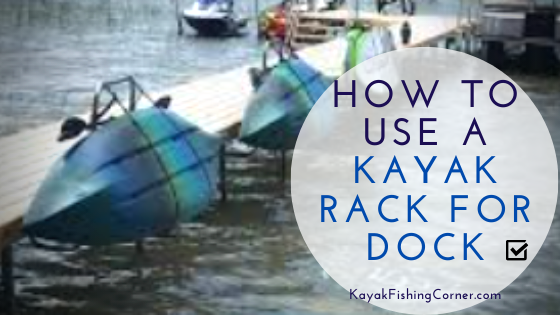Jump Ahead To:
HOW TO USE A KAYAK RACK FOR DOCK – INTRO
Carrying a bulky kayak to the dock every day can be tiresome. A kayak rack makes accessing your fishing kayaks a whole heck of a lot easier! Read on to learn how to use a kayak rack for dock based kayak storage, you’ll be glad your did?
Not familiar with kayak racks for docks? Not to worry – you can learn more by reading our Ultimate Guide!
How to Use a Kayak Rack for Dock – Overview

Please note: This post contains affiliate links. An affiliate link means that we may earn advertising/referral fees if you make a purchase through our links.
Kayak racks can be quite a confusing topic for many people – even those who are very experienced or skilled kayak fishermen! The purpose of this guide is to help you learn how to use a kayak rack for dock based kayak storage!
For accessibility, I’ve divided the guide into various sections. The first section talks about the basics of kayak racks, why you need them, what they are, a bit about installation, and some other particulars.
I’ve delved deeper into the installation in the second section, where I’ve broken it down into a step-by-step guide. This section will serve you as a VERY easy to use “how to” list – a feature that KFC is becoming famous for!

Next, I’ve mentioned all of the important considerations that you need to make before buying a kayak rack for dock storage. You’ll learn here about how you can choose the best kayak racks for yourself. If you memorize each of these important features, you can be assured that you’ll be happy with your purchase!
After that, I’ve linked to my favorite kayak rack for dock storage. It’s a handy rack that’s quite versatile and fairly durable. Now, by no means is it the ONLY top quality kayak rack on the market – but it is one that contains each of the important features that I highlight in this post!
If you want to hear my thoughts on it, I’ve summarized them in the “My Experience” section.
So without any further ado, let’s begin the guide!
How to Use a Kayak Rack for Dock – Basics

Please Note: As an Amazon Associate, I earn from qualifying purchases.
Shortcut to the Best Kayak Rack for Dock Review
Do you want to secure your fishing kayak to your dock for the next time you use it? Then what you’re looking for is a freestanding kayak rack!
Notice how I said, “freestanding.” It is because the word “kayak rack” is used to describe two kinds of racks: car-top and freestanding. Car-top racks are useful for transporting the kayak by car. Freestanding racks, on the other hand, are meant for long-term storage (like on your dock or even in your garage or basement) rather than active transportation.
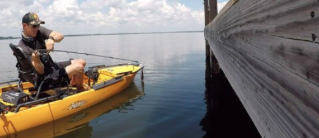
Kayak racks require some prior knowledge of hardware and setup. But if you have an instructions manual by your side, you can pull it off quite easily – of course, this guide will be helpful to you as well.
So why do you need a kayak rack? Securing a kayak to a dock means you don’t have to worry about transportation. You can use your kayak right from the dock! This is tremendously important, especially if you don’t have a partner to help lug your kayak to and from the water!
How to Install a Kayak Rack for Dock

So how do you install a kayak rack on your dock? Set up varies from product to product, but the installation can be generalized to some extent.
If your kayak rack isn’t too fancy, then this installation guide will apply to you. Here’s how to install a kayak rack on your dock:
- Remove the components from the box and use the installation guide to identify the parts.
- Your kayak rack should consist of two dock mounts, a stand, hooks, and saddles or straps.
- Sometimes the rack will have legs that screw directly onto the dock.
- Decide whether you want to have the rack facing the water or the dock.
- Install the dock mount onto the very edge of the dock.
- Attach the main stand/tower of the rack to the mounts/legs.
- Finally, attach the hooks using the prescribed screws or nuts, and secure tightly.
- If your rack includes straps, connect them from each hook to the tip of the stand.
- Now place your kayak or kayaks on the rack and secure them with the strap.
- And you’re all set!
Side Note: Did you find this list to be helpful? You might also like our guide on How to Use Kayak Outriggers or How to Install a Kayak Brush Gripper! We have written extensively about the Best Kayak Brush Gripper, here!
How to Use a Kayak Rack for Dock – Important Features

Freestanding vs. Car-Top:
Kayak racks can be found in two styles: freestanding and car-top. Of these, only the freestanding style can be used on a dock. But so many people unknowingly buy the wrong kind, which is why it’s important to know which kayak rack is made for docks.
Freestanding kayak racks use j-shaped hooks to hold the kayak up. They either come with a dock-mount, or the legs can be screwed into the dock. You can identify this rack by its unique upright design that car-top racks don’t have.
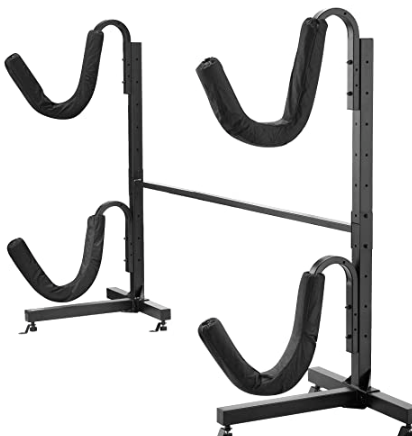
Car-top racks, on the other hand, have a more horizontal than vertical design. And as the name suggests, they are great for initially transporting the kayak from your garage to the dock. If you’re transporting the kayak by car, you’ll need to buy a car-top rack along with the freestanding one.
Capacity:
There isn’t much variety when it comes to capacity. Most freestanding racks can only hold two kayaks at a time. But there are a few that can hold up to three kayaks.
What you may be more concerned with here is the weight capacity. Kayaks can vary in weight from 35 lbs. to all the way up to 100 lbs or even more!
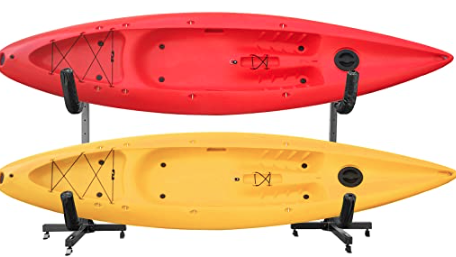
The total weight capacity of the rack is stated for two kayaks, not one. So a 100 lb. kayak rack can hold two kayaks of 50 lbs. And no, it is not recommended to store just one kayak of 100 lbs, on such a rack.
Hardware and Attachments:
Aside from the parts of the rack, it is a good idea to go for a kayak rack that includes all the needed hardware. This will save you a trip to the hardware store and a whole lot of guessing. This includes the screws, nuts, bolts, and sometimes even Allen wrenches. A lot of kayak racks come with saddle straps to prevent the wind from knocking your kayaks over.
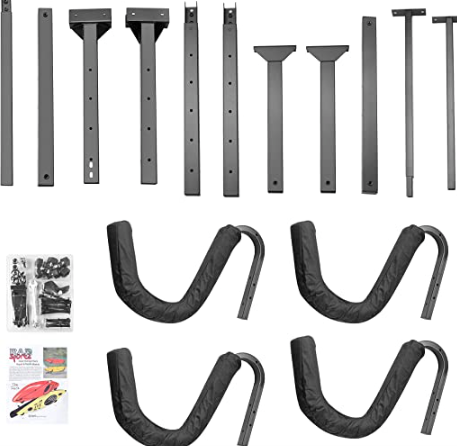
Sometimes, you’ll get these hardware components completely free with the rack. So don’t miss out on such a deal. If the kayak rack doesn’t come with the hardware included, you can get them at a fairly reasonable price from your local hardware store (but, again, we suggest that you save yourself a trip and buy a rack that has everything included).
Material:
Many kayak racks are made from aluminum alloy. If you’re unfamiliar with this, aluminum alloys are great at reflecting heat and light. So they are more or less UV resistant and don’t heat up in the sun. And they’re also 100% rust-proof.
Your only concern may be saltwater, which is extremely corrosive to metals. A simple powder-coating can overcome the problem. Only a handful of kayak racks come with powder-coating, and they are usually the “top tier” models!
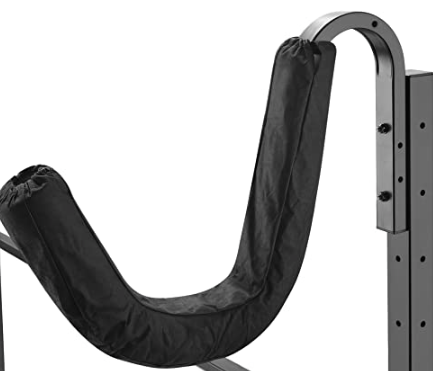
Stainless steel that has been powder-coated or galvanized is another smart choice. However, it weighs more than aluminum and leaves (or might leave) tougher scratches on your kayak. But steel is stronger, and if the hooks are padded with foam, you don’t have to worry about scratches.
Versatility:
Finally, look at how versatile the product is. If you’re constantly switching between different weights and sizes of kayaks, you’ll need a more versatile rack.

Length is not an issue here, but weight and width are. Most racks are standardized for what are known as “sit on top” kayaks. Most can also be used for what are known as “sit in” kayaks. But whitewater kayaks are wider and take up more space. You can confirm with the manufacturers to know the exact distance between adjacent hooks.
Want to become an even more proficient kayak fishermen? Learn how to use a Kayak Anchor Trolley to become more effective at anchoring over the school of fish your are after!
Buy The Best Kayak Rack For Dock
For keeping my kayaks secured by the dock, the showcased model is my go to. And the reason? Everything from the powder-coated steel to the soft padded hooks set this rack aside from the others.
In terms of how strong and durable this is, consider the fact that it uses stainless steel. I’ve already mentioned that stainless steel is a highly durable product, even more so than aluminum. It doesn’t rust, at least not with the powder-coating.

And with the powder-coating, you can also expect this rack to perform in the sun – a very important consideration for “open sided” fishing docks. It also adds a double layer of protection against water (one from the coating and one from the steel itself).
One thing I noticed and admired here is the use of padded hooks. The metal of the hooks can be made as hard as possible without the kayak getting scratched. It also allows you to just dump the kayak on the rack without worrying about impact damage.

And the best part is that even the padded sleeves are UV-protected! So every part of this rack can take quite the beating.
As for versatility, this rack is 26 inches deep and 94 inches wide. These type of specifications are broad enough to hold kayaks of nearly any standard size or shape! Now if only there was a kayak paddle holder that was so versatile…

Unlike some other racks I’ve seen, the legs of this particular rack can be screwed in three places. Each leg is a tripod of sorts that, while requiring more screws and work, secures your kayaks against a heavy wind. This is also a nice level of reassurance in terms of protection against the “rocking” of your dock when a big wave passes through!
If you have a heavier kayak, this particular kayak rack can take care of it. This rack has a weight capacity of 175 pounds, which means 87.5 pounds per kayak. So it’s a good choice for heavier kayaks.
My Experience

Now it was finally time to put this rack to the test. Initially, I did struggle with installation, but only because I was new to it. I am NOT a handyman, so I thought it may take me some time. All the necessary hardware, including the nuts, screws, and the wrenches are there, along with an instruction manual. This is VERY helpful!
Once set up, my kayak rack was able to withstand almost everything. The soft foam sleeve prevents kayaks from scratches. And I found that once I screwed the legs in, nothing could move them.
Here’s what I thought of the kayak rack in my world famous “pro” and “con” list style:
Pros:
- Resists high winds and UV light (great for “open air” docks).
- Does not scratch the kayaks.
- Includes hardware and installation guide (saves trips to hardware store).
- Survives both fresh and saltwater splashes.
- Great for the heaviest of kayaks.
Cons:
- Heavy if you want to transport it whole (suggest disassembly when moving).
- Hooks are not adjustable.
Conclusion

And that concludes the guide! I highly anticipate that the above information was of use to you. And I hope that now you know more about kayak racks than you did before. I know that I even learned more when I began to put “pen to paper” to write this article!
Now, if you ask me which kayak rack I like the best, the showcased model would be my answer. It’s one of the most durable, isn’t flimsy, and can survive practically everything. The only catch is that it’s heavy, but you’ll work around that, especially if you follow the instructions and the reference guide above!
Comments

But wait, do you have a better option in mind? Have you tried my suggestion before and not liked it? How did you learn how to use a kayak rack for dock based kayak storage? Maybe you have a friend who showed you the ropes? Maybe you figured it out for yourself? Be sure to post below on the Comments board and share your story with us! We read and reply to every comment and LOVE interacting with the kayak fishing community!

